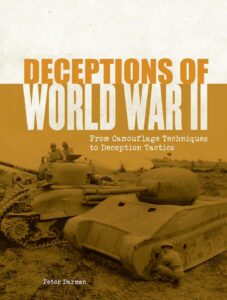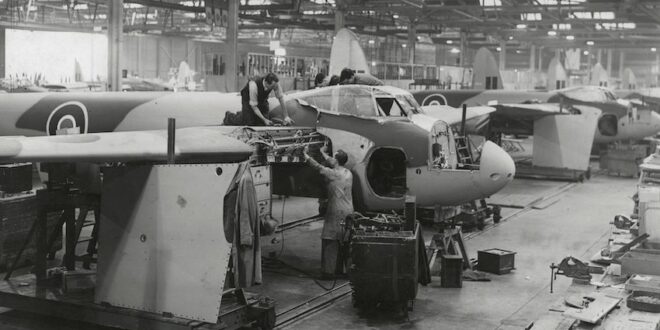 Article extracted from Deceptions of World War II: From camouflage techniques to deception tactics by Peter Darman, published by Exisle Publishing, RRP: $44.99.
Article extracted from Deceptions of World War II: From camouflage techniques to deception tactics by Peter Darman, published by Exisle Publishing, RRP: $44.99.
In response to the belief that “the bomber will always get through,” the British implemented both simple and elaborate deception measures to evade the bombers of the Luftwaffe in 1940. As the tide of war turned against the Third Reich, the Germans themselves adopted defensive deception measures to thwart Allied bombers. But one of the biggest defensive deception operations was that carried out by the Americans, who camouflaged large parts of California during the war.
Defensive deception is as old as warfare itself, with commanders seeking to mask their deficiencies against superior enemies either to allow themselves to withdraw unmolested or to deter the enemy from attacking. In an age before modern communications and observation techniques, especially in the absence of binoculars and telescopes, simple ruses could be highly effective on the battlefield. In 73 BC, for example, during the slave revolt in Italy, the commander of the slave army, Spartacus, found himself penned into camp by the Roman praetor Publius Varinius. Short of weapons and food, and unable to forage for supplies because of the proximity of the Romans, Spartacus had no option but to withdraw. Some 10,000 slaves evacuated the camp during the hours of darkness, leaving corpses propped up on stakes in front of the gates to deceive the Romans. Dressed in clothes and “holding” spears, they appeared to the Romans to be guards. This successful ruse was reinforced by burning campfires, which had been lit before the slaves escaped.
The introduction of gunpowder expanded the possibilities of defensive deception, the threat of being decimated by cannon fire often deterring commanders from ordering attacks. During the American Civil War, for example, the Confederates used so-called Quaker guns—logs or stovepipes painted black to resemble cannon—to hold Munson’s Hill near Washington for three months in 1861. The advent of airpower, however, changed the nature of warfare profoundly, and forced belligerents to adopt new methods to deceive enemy aircraft.
The airborne threat
The introduction of airpower into warfare in the early years of the twentieth century, and its subsequent use in World War I in close air support, reconnaissance, interdiction, air defense, air superiority, and strategic bombing, led to the belief in the interwar years that it would have a decisive impact on any future war. In Europe, this was developed further by figures such as the Italian General Giulio Douhet and the first commander of the Royal Air Force (RAF), Viscount Trenchard, who took the view that the bomber would always get through, and that the strategic bombing of population centers would win the next war. Trenchard was the head of the Royal
Flying Corps in World War I and was appointed Chief of the Air Staff of the RAF after the war. During World War I he had always favored the use of mass air power, and after the war he became an advocate of strategic bombing. He had a major influence on the RAF’s ideas and institutions. In the United States, though, the Air Corps Tactical School devised an air doctrine that focused on disabling the enemy’s economic system by targeting and destroying crucial industries: electrical power and ball bearing plants, for example. But both the European and U.S. doctrines assumed that ultimately the bomber would always get through. The bombing of towns and cities by the Germans during the Spanish Civil War (1936–39), especially the bombing of Guernica in April 1937, seemed to confirm this, and the destruction inflicted upon Warsaw by the Luftwaffe in September 1939 made the governments of Britain and France fear the worst. But if the bombers always got through, it did not follow that they would always hit the real target.
In response to the enemy threat, the British were already working on the development of camouflage (to hide targets) and decoys (to draw enemy attacks away from real targets), to dilute enemy airpower when the Luftwaffe launched its campaign against Britain in July 1940 (with attacks on RAF bases beginning the following month).
The British Air Ministry had set up a staff branch within the Air Staff to organize a system of decoys for RAF stations in October 1939, headed by Colonel Sir John Fisher Turner, Royal Engineers. Formerly Director of Works and Buildings at the Air Ministry in London, he was a qualified pilot who had a knowledge of airfield construction and infrastructure. His headquarters was located at the Sound City movie studios, Shepperton, Surrey. The branch was known for purposes of secrecy as Colonel Turner’s Department (CTD). It masterminded the Day Decoys (K sites) and Night Decoys (Q sites), which were established throughout Britain early in the war to deceive enemy bombers and reconnaissance aircraft. It was the first time Britain operated a nationally coordinated system of decoy targets to mislead enemy bombers. By June 1940 France had fallen to the Germans, and the Luftwaffe was about to commence its air offensive against Britain as a prelude to an invasion of the British Isles. By this time Turner’s department had been hard at work. The first Q site was operational by the end of January 1940; there were 20 by May 1940, 42 by June, and 79 by the end of 1940. The rate of construction was speeded up after the fall of France, and by the time the program was halted in March 1943 there were 170 Q sites in total.
Because they operated at night, Q sites were relatively easy to establish and maintain. To lure Luftwaffe night bomber fleets, it was necessary only to simulate the forms of lighting normally used on an RAF airfield. The sites were thus not constrained by the need for flat terrain: hedges and crops presented no difficulties as lights were simply mounted on poles, with cables laid along hedges or buried beneath the earth, where required.
Q sites usually had a staff of two or three RAF personnel who would check the lighting before dusk and await enemy aircraft in a shelter. They had a manoeuvrable light that looked like the light of an aircraft to attract the attention of an enemy pilot. Yellow lights imitated a T-shaped wind direction indicator and headlamps replicated taxiing aircraft. To avoid compromising friendly flying safety, certain lights were omitted or deliberately introduced to identify Q sites to friendly aircrews without being noticed by enemy aircraft, which in turn required constantly briefing RAF aircrews. Dummy lights were operated for an average of 20 hours per week on each Q site, and results were impressive. In 1940, for example, there were 90 Luftwaffe attacks on RAF stations, but 174 on Q sites. The ratio was 360 to 359 at the end of 1941, and 434 to 443 by the end of May 1944, when German night bombing raids against Britain ended. A typical Q site was Foston in Lincolnshire, which acted as a decoy for nearby RAF Bottesford, from where Lancaster bombers of 207 Squadron operated between November 1941 and September 1942. Further Q sites for Bottesford were located at Tithby, Nottinghamshire, and Belvoir, Lincolnshire.










Join the Discussion
Type out your comment here:
You must be logged in to post a comment.